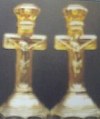Carnival Glass 101 | home Quick Reference to Carnival Glass Patterns on This Site
Fascination of Similarities
FASCINATION of SIMILARITIES
Northwood-Dugan DAISY and PLUME examples: Northwood examples, which are trademarked, have three flowers each, surrounded by 74, 75 and 76 beads respectively. The three feet have a protruding rib running parallel to the center of each foot. The Dugan/Diamond variant, which is known in peach opal, has 80, 81 and 82 beads surrounding each flower respectively, and no protrusion on the three feet. The bead count comes from Janet Knechtel who used three examples from her own and her mother-in-law's collection for comparison study. These are near-identical copies from two different manufacturers. GRAPE AND CABLE, PEACOCK AT THE FOUNTAIN and possibly PEACOCK ON THE FENCE are other copy possibilities which have been discovered.
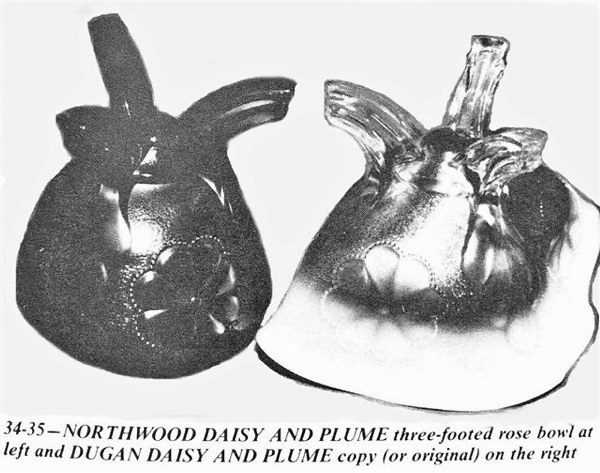
Northwood Daisy and Plume on left - Dugan Daisy and Plume copy (or orig.) on right.
Northwood Daisy and Plume and its “Look-Alike” from Dugan (upside down): were displayed in an early GLASS DIGEST edition, the article exploring which came first?
Since both companies made their versions of this interesting pattern with “splayed feet”, assumption was made that Dugan copied the Northwood design. However, as Carl O. Burns relates in his 1999 Dugan & Diamond book, more refined evidence indicates quite the opposite to be true.
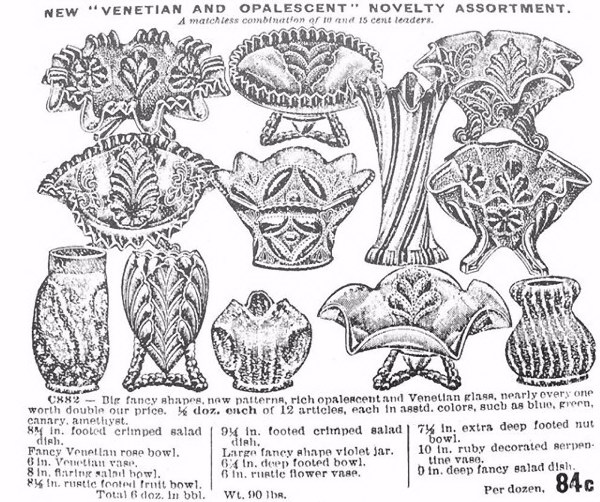
Mid-Spring 1907 Butler Bros. Wholesale Catalog
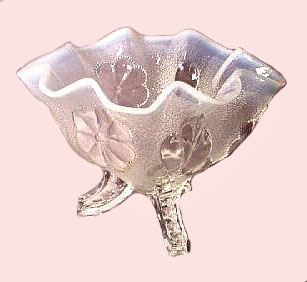
DAISY and PLUME in Opalescent form
1907 Butler Brothers Wholesale Ad: indicates that Dugan produced the pattern in non-iridized opalescent colors before the era of Carnival Glass. The Northwood version does not appear in wholesale catalogs until late 1909. This provides affirmation that origination came from Dugan, with Northwood being the copycat.
OPALESCENT DAISY and PLUME: An interesting sidelight to this piece when advertised for sale: Each of three holes in the feet is of a different size. We have heard discussions over the years concerning some examples in carnival glass which have holes in the feet. Since the 1907 ad is obviously for Dugan Opalescent selections, we might assume that it is only those examples made from their mold which provide the holes. The copycat versions later made by Northwood lack the holes?
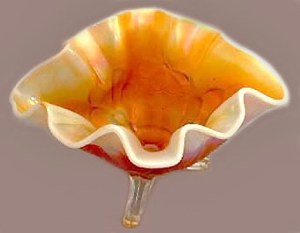 |
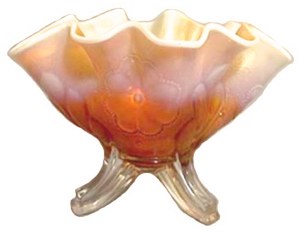 |
DUGAN DAISY & PLUME Candy Dish - 7.75 in. wide x 5 in. tall.
|
Peach Opal footed DAISY & PLUME - Dugan.
|
Dugan DAISY & PLUME: A myth that this piece is always found having round holes in each of the three feet has been put asunder by Carl O. Burns' statement that he has owned some examples without the holes. This boat shape seems to be unique to Dugan since the “rose bowl shape” has not been found.
Limited color range and some difficulty in finding this version, primarily on the exterior surface of ruffled candy dishes, it is suspected that the production period was limited. Marigold, amethyst, lime green with marigold overlay, and peach opalescent are the selection choices, with amethyst being least often found. Peach opalescent provides the most attention. Possibly fewer than six examples are known in lime green.
Interior surface is usually plain, but on occasion, a ruffled example carrying Dugan's Cherry interior pattern may be located. At least a couple of examples in amethyst have been reported in this 8”-9” footed bowl.
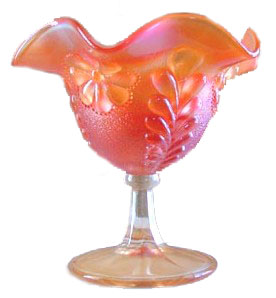 |
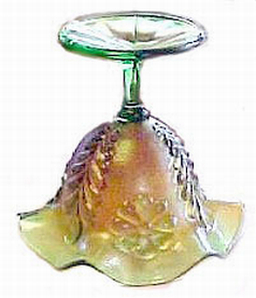 |
DAISY & PLUME compote 5.25 in. tall x 5.5 in.across opening.
|
DAISY & PLUME Stemmed Compote-5 in.tall x 5.75 in. wide at opening.
|
Northwood DAISY & PLUME stemmed, ruffled compotes: The same mould was used to fashion these ruffled examples.
Marigold, amethyst and green are the color choices in this variety. Most have a plain interior.
More rare are the few examples which have the FERN pattern on the interior. White is an additional color which has been reported? (During our more than 30 years of intensive search for unusual pieces, we have never seen a white example!)…………If you will click on - F - in our pattern alphabet index, you will find a lovely green example pictured there, along with more descriptive information.
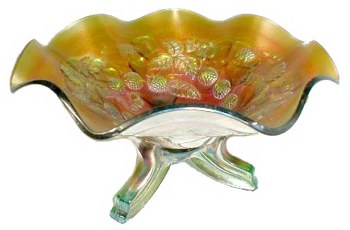 |
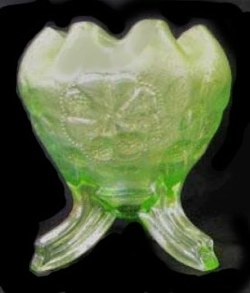 |
DAISY and PLUME Candy Dish with BLACKBERRY Interior in Green.
|
DAISY & PLUME-Ice Green with Berry Interior.
|
Northwood DAISY & PLUME Candy dish with Blackberry Interior: Marigold, amethyst, green, white, ice blue, ice green, lime green comprise the color selection on these lovely three footed pieces.
These are found far less often than the rose bowl shape. Amethyst examples are much harder to locate than green and marigold. The ice colors are least often seen. Ice Green and Aqua Opal rose bowls with the Berry Interior are quite rare.
Nearly all Northwood examples of both stemmed and three footed types are marked with an N-in-a-circle. Dugan examples are unmarked.
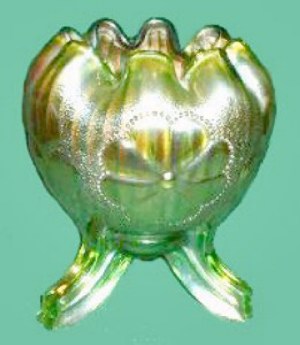 |
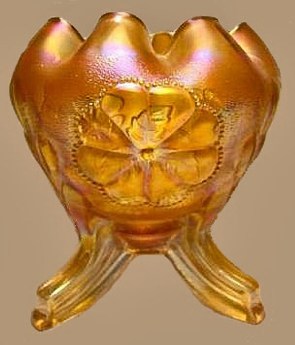 |
DAISY & PLUME in Green-displays the Rayed interior.
|
DAISY and PLUME Rose bowl - Five and one-eighth in. tall.
|
Northwood DAISY & PLUME Rosebowl with (RAYED Interior): This rose bowl shape is the most popular shape and is seen more often than any of the others. Sometimes these green examples are found to have what is termed Northwood's Alaskan iridescent finish, which is simply marigold applied over the green base glass color.
This particular green rose bowl is somewhat unusual in that it is iridized on the interior only, and has the Interior Rays design, as well.
What can we say? “Just marigold”? Indeed it is! When marigold like this appears on the scene, everyone wants an example! Marigold, amethyst and green present themselves fairly often. Cobalt blue is very scarce, along with lavender.
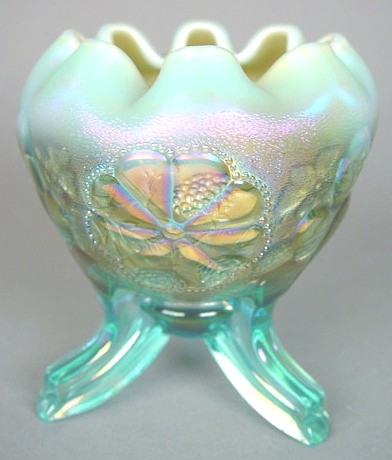
DAISY & PLUME Rosebowl in Aqua Opal
Northwood DAISY & PLUME Rosebowl with Plain Interior: Aqua Opal, white, ice blue and ice green examples are all very rare, but topping the list are the aqua opalescent rose bowls. We know that existence of this color confirms the fact that the design was still in production during the 1912-1913 period when this color was at its height of popularity. Three to six examples are the extent of availability and on the rare occasions when one surfaces, at least a five figure price is required for ownership.
Dean & Diane Fry --- 9/06
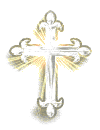      |
|
But reject profane and old wives' fables, and exercise yourself toward godliness.
For bodily exercise profits a little, but godliness is profitable for all things, having promise of the life that now is and of that which is to come.
This is a faithful saying and worthy of all acceptance.
1 Timothy 4:7-9
|
|
      |
Should you care to contact the Frys, their email address is:
Search Our Sites
back to Carnival Glass 101
Our other sites you may enjoy:
Everything you EVER wanted to know about Indiana Glass
Great Reference for Newer Carnival Glass.
Complete Glassware Catalogs Available to Download
Questions? Comments? Suggestions? Broken Links? Corrections?
Your Friendly Webmaster is here to help!
